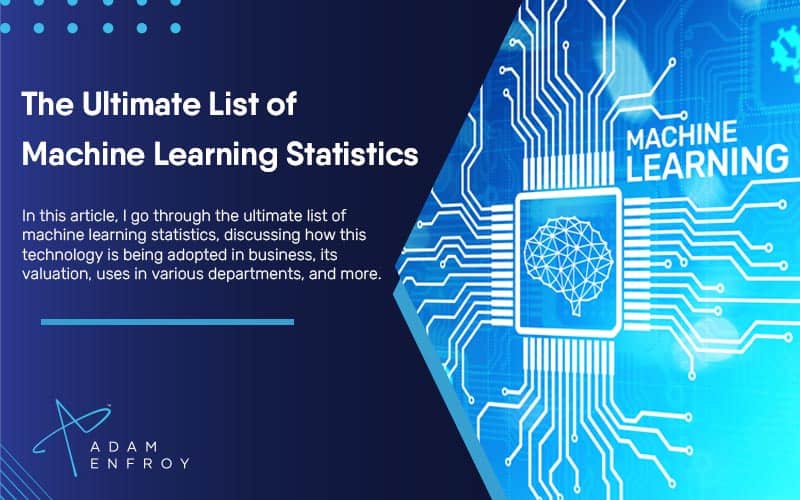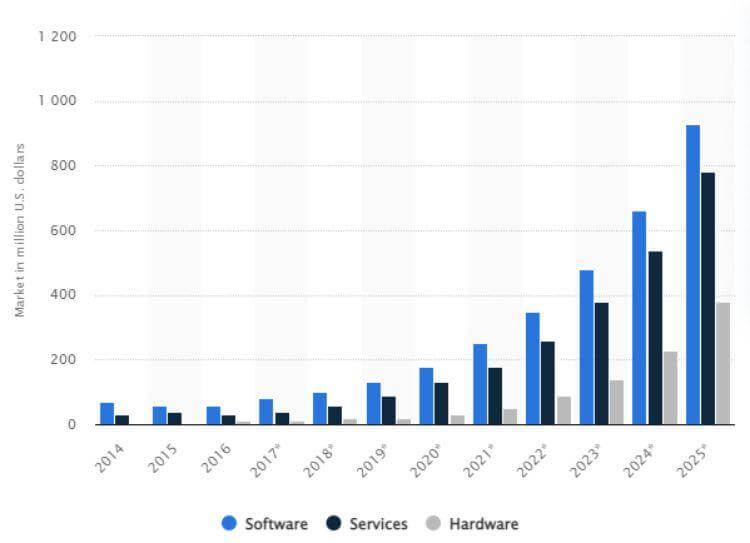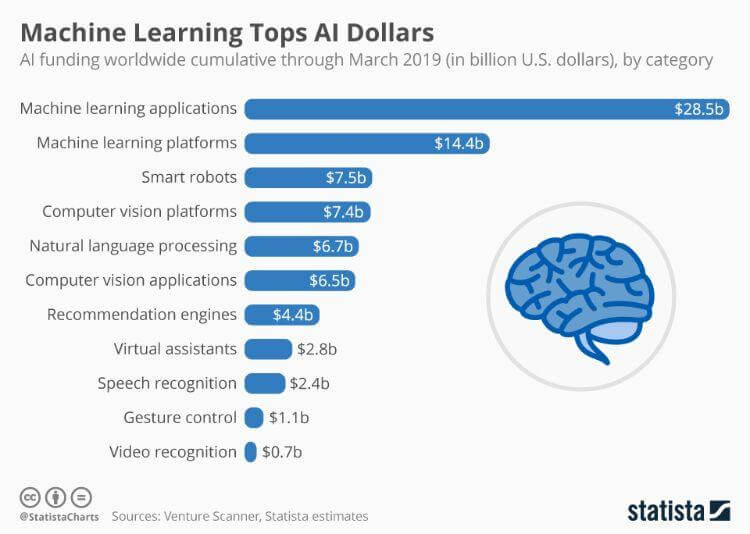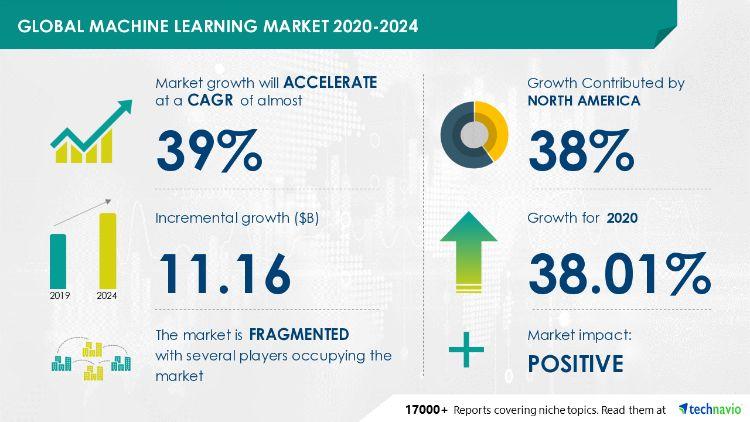The Ultimate List of Machine Learning Statistics for 2024

Machine learning has seen its popularity increase exponentially in recent years due to several academic and industrial researchers pushing out exciting products into the market.
As a result, machine learning has become a prevalent topic among many stakeholders.
Various business intelligence tools and enterprise software applications use machine learning algorithms to predict future trends and patterns.
Machine learning opens up a whole new world for analysts by helping them find hidden insights and detect subtle patterns and variations in large sets of data.
In this post, we’ll cover the top machine learning statistics that you should know, which will make it easier for you to understand how this topic is evolving.
You’ll also be able to understand whether the features found in machine learning software are right for your business.
Let’s dive deep into this topic.
Adopting Machine Learning (ML) In Business
1. Business analytics is a big area for machine learning use, with one out of every three I.T. leaders wanting to use this technology.
(Statista)
Using machine learning in business has become essential because companies generate terabytes of data every second.
This is why many applications have sprung up which can use machine learning algorithms to help people understand better what specific data means in terms of business.
2. There doesn’t seem to be many cost decreases when using ML. On the other hand, revenue increases are widely reported, with 80% of surveyed people saying that A.I. and ML help with this.
(McKinsey)
One would expect that fundamental cost decreases would happen when leveraging machine learning algorithms. Instead, the truth is that revenue ended up increasing due to this technology.
While this is not bad, some might be surprised that the two factors do not happen simultaneously.
The good news is that 80% of organizations who have used machine learning say that the technology has helped with their revenue.

Captioned Above: Deep learning market revenue in the U.S. over the year
Image Credit: Statista.com
3. Security is a top concern in any business, with 25% of I.T. leaders wanting to use machine learning for this purpose. A further 16% say machine learning is great for marketing and sales.
(Statista)
Security is one of the biggest concerns for any business, and it’s no different for I.T. leaders.
As machines are getting smarter day by day, hackers find new ways to outfox them.
However, it seems that machine learning algorithms can help with this issue.
When it comes to marketing and sales, many businesses have begun using ML algorithms for targeted marketing, which has proven to be much more efficient than blanket advertising.
Machine Learning Market Valuation
4. By 2025, the U.S. machine learning and deep learning market will amount to $80 million.
(Statista)
The value of both the U.S. machine learning and the deep learning market will be upwards of $80 million by 2025.
While this number is already massive, it’s expected to increase even further as more companies start leveraging these algorithms for their benefit.
Deep learning is the most advanced machine learning algorithm possible and is currently being used to improve businesses, with the trend showing no signs of slowing down.

Image Credit: Statista.com
5. A CAGR of 37.60% from 2019 to 2026 is expected in the A.I. hardware marketing, bringing the final valuation up to $87.68 billion.
(NeighborWebSJ)
The compound annual growth rate (CAGR) for the hardware market is expected to be 37.60% every year during these seven years.
While most people associate A.I. with software, the hardware aspect is equally important.
Current AI applications (ranging from chatbots to factory machinery) rely heavily on computing power, and such hardware is expected to become even more relevant in the future.
6. COVID-19 has been responsible for a decrease of 12% in the A.I. chip-making business.
(Market Data Forecast, 2020)
The global pandemic has slowed down the growth of the machine learning chip-making business to some extent.
With a 13% decrease in overall sales, some might have predicted a higher drop than this in the A.I. market.
At the same time, more significant reductions were observed in many other markets, so it’s no surprise that some slow down happened.
Machine Learning In Top Organizations
7. A.I. use has increased high-level business productivity by up to 54%.
(Oberlo)
Business productivity is one area with a lot to gain from machine learning algorithms.
According to a study by Oberlo, AI use is responsible for optimizing high-level business productivity by up to 54%.
In other words, one can say that machine learning helps employees in these organizations become more efficient, which leads to increased profits and revenue generation.
8. C-level executives personally oversee 75% of all A.I. projects in their firms.
(Fortune)
The people who hold top positions (and are responsible for company-wide decision making) personally oversee 75% of all A.I. projects in their firms.
In the past, many top executives were barely aware of what machine learning was, let alone what was going on with machine learning algorithms in their firms.
With so much hype around this technology, the situation has changed drastically.
These days, top executives can’t afford to ignore what’s going on with A.I. and machine learning.
9. A.I. Business Investing is something that 91.5% of leading businesses are involved in.
(Businesswire)
A.I. Investing software is becoming more prevalent every day.
According to a study by BusinessWire, more than 91% of leading businesses are involved in this type of investing.
Even more impressive is that the number of organizations seems to be increasing every year.
Many investors within significant companies can see the upside of machine learning algorithms, and they’re allocating more resources to this emerging technology.
Machine Learning In Various Departments
10. Customer service and A.I. go hand in hand – more than 80% of companies will use A.I. in this department.
(B2C)
With clients demanding more value from every business interaction, it’s becoming clear that companies will need to adjust if they want to keep up in business.
More than 80% of firms plan to eventually use A.I. in the customer service department, allowing them to provide a better service and deliver a top-notch product that clients will appreciate.
A.I. can also help companies improve the customer experience using automation in certain aspects of this process.
The way companies interact with their customers is changing, and machine learning algorithms seem to be a significant part of this shift.
11. Less than 15% of overall businesses said they would use A.I. in widespread production.
(Businesswire)
When it comes to produced products, only a minor percentage of businesses in the world will seemingly use an A.I.
While this is seemingly relatively low, it’s still more than what was expected at this point, especially when you consider that the machine learning industry is quite a recent development.
12. By Q4 of 2019, Tesla had traveled more than 1.88 billion miles autonomously.
(Forbes)
With Tesla being well known for its autonomous driving cars, it’s interesting to see the overall machine learning approach applied to this industry.
According to a study by Forbes, Tesla had traveled more than 1.88 billion miles autonomously by the end of 2019.
Being a few years old, this particular statistic is even more impressive, considering several years have passed since it was recorded.
The good news is that with such a high number of miles already driven, these autonomous vehicles have been extensively tested on a large scale.
This means that Tesla-produced cars reduce the environmental impact and hopefully make our roads safer.

Image Credit: Businesswire.com
Machine Learning in Voice Assistants
13. As much as 50% of the world population use voice assistants.
(Review42)
Voice assistants are becoming widely known and incorporated within many households.
As this technology becomes more advanced and the voice assistant market continues to grow, it seems as if half of the world already uses a voice assistant.
Getting stuff done by voice commands is becoming a popular choice for many people who want to improve their productivity in various areas of their lives.
Companies that bet on A.I. are slowly beginning to see the rewards of their efforts.
Those that have invested in voice assistants surely fall into this type of category.
14. The global COVID-19 pandemic increased voice A.I. usage by 7%.
(AUM)
The global pandemic also seems to have impacted voice assistants usage.
According to a study by AUM, the COVID-19 pandemic increased voice A.I. usage by 7%.
This is crucial data for companies on the fence about incorporating machine learning in their voice assistants (and taking voice-assisted capabilities to the next level) since demand is only expected to rise in this area.
15. Using voice assistance multiple times a day increased by 5% in six months.
(Voicebot.ai)
In the recent past, many people didn’t seem to find much use for voice assistance in their daily lives, only using it once a day.
However, surveyed people said they have begun to use it more over time, increasing by 5% over a six-month period.
Companies need to incorporate voice assistants into their business plans instead of relying on traditional ways to interact with products.
To offer a personalized service, companies should ideally do this through machine learning that adapts to customers’ behavior and needs over time.
Other Interesting Machine Learning Statistics
16. machine learning improved 47% of their sales and marketing efforts for early adopters.
(Deloitte)
In business, being at the forefront of technology can significantly impact the way your company operates.
By implementing machine learning into their sales and marketing, 47% of surveyed companies saw an increase in the number of customers and the efficiency they provided their products and services.
17. There are almost 100,000 jobs worldwide that require machine learning. Nearly half of them are in the U.S.
(Forbes)
Knowing how machine learning works pays off – literally.
Almost 100,000 jobs worldwide requiring machine learning knowledge can be found on LinkedIn.
Almost half of these jobs are based in the United States.
This shows that it is crucial to be knowledgeable in this area, as knowing the correct information can help you in various career paths you might want to pursue.
18. 62% of surveyed customers have no problem sending their usage data to an artificial intelligence platform to improve machine learning and ultimately improve customer experience.
(Salesforce)
While privacy concerns are always at the front of many people’s minds, it seems that they are willing to give up some of their privacy to improve various aspects of their lives.
62% of customers surveyed said they had no problem sending their usage data to an artificial intelligence platform to improve its machine learning algorithms.
As long as the company improves the final product based on this data, customers are OK with sharing it.
What Is Machine Learning?
Machine learning models are self-improving models that get better the more times they are run.
Their performance improves with knowledge, and one can speed up their improvement by providing them access to large amounts of data, computing power, and advanced algorithms.
Machine learning models are very good at recognizing patterns, even when presented with a data set containing noise or missing information.
Machine learning also excels at extrapolating from small amounts of input data – for example, by generating high-quality recommendations in the absence of complete user profiles.
The global machine learning market has been getting bigger and bigger, and will stay this way over the next several years.
The good news is that machine learning methods are used in various business situations, including scientific research, engineering applications, machine translation, data mining, and more.
Most people also believe that job growth and demand for this particular skill set will continue to increase over the next few years.
The Difference Between Artificial Intelligence and Machine Learning
While a machine learning model is very flexible in what it can do, an artificial intelligence model is more adaptable.
Artificial intelligence (A.I.) is a multiplying form of technology – many consider A.I. to be the next significant technological advancement.
In a way, an ML model is a subset of artificial intelligence because it enables a machine to learn how to become better at a specific task.
How a Machine Learning Model Gets Better
Data science is one of the primary ways machine learning happens.
Being a much-needed field in this day and age, data science has many benefits that can help make one’s life easier.
To improve machine learning algorithms, the models used for data science need access to any and all available data to make predictions.
As a result, these models often end up accurately predicting stuff even if they’ve received information that wasn’t part of what was used to train them.
Machine learning models are trained with examples of input data and the correct corresponding outputs to accomplish this.
The model can examine the difference between the values it predicted and what was expected and adjust accordingly to make its predictions more accurate in the future.
Machine Learning Algorithms
A machine learning algorithm is a step-by-step procedure that uses input data to make predictions.
Machine learning algorithms can help make your job easier by taking some of the load off you or your company.
Computer science helps machine learning algorithms get better by providing them with more computing power and access to larger data sets.
These models assess statistical properties to identify patterns extrapolated to new situations as they receive this data.
Statistical Methods
These are used in a machine learning system to help it better understand complex relationships in data.
For a machine learning system to work, it must draw inferences from the input data to make accurate predictions in real-world scenarios.
Some examples of statistical methods include linear regression analysis, Bayesian analysis, and clustering.
These enable a model to understand better how different factors relate to each other.
Statistical models are also crucial in a machine learning method that takes previous examples to predict what will happen next.
Exploratory Data Analysis
Machine learning techniques involve training and testing to develop a predictive model from several samples.
The first step in this process is to look at data and make certain assumptions about its nature.
One type of this analysis is called exploratory data analysis, which examines the distribution of features within your input data set.
This doesn’t tell you anything definitive about what you can expect in the future, but it can help you make inferences about what type of model may be most effective in predicting the correct outputs.
Regardless of whether these predictions are for supervised or unsupervised learning, all machine learning models require an exploratory data analysis step at some point when developing predictive and linear models.
The Importance of Machine Learning in Various Job Positions
Having background knowledge in statistical modeling can help you to get ahead in the world of machine learning, which is why it’s so crucial for job seekers to understand what this area is all about.
With the focus of many traditional jobs shifting from repetitive tasks to relatively more complex ones, this skill set is one of the best learning investments you can make.
In some cases, this can require a college education, so if this is an area you’re interested in, it may be beneficial for you to begin by earning your bachelor’s degree in data science.
This field shows strong potential and can prepare you for a future in a wide variety of different job settings.
Big Data and Its Impact on Machine Learning
I can’t speak about machine learning without mentioning Big Data and the impact this has had on the field.
With the amount of data created expected to reach more than 180 zettabytes by 2025, machine learning is one of the most promising applications of Big Data.
With an increase in data sets making them more significant than they’ve ever been, there are many opportunities for those interested in this growing area.
Items such as decision trees, cross-validation, and reinforcement learning all profit from the availability of large, high-quality data sets.
Another concept that is helping make everything better in this area is called overfitting.
This concept in data science is used as a classifier when measuring the error rate and helps progress machine learning.
With universities such as MIT and Harvard now offering certificates in data science, this field is one that many students are pursuing.
Other Machine Learning Considerations
Statisticians use statistical learning and supervised learning techniques to help with logistic regression and other prediction models.
These aspects of machine learning have benefitted companies by taking some of the load off their employees, who are now free to take on more complex tasks that move the needle in their business.
Moreover, the low barrier to entry in computer languages such as Python help learners and those studying neural networks to bootstrap their learning projects.
Many tools assist with the visualization of algorithms to see what is happening behind the scenes.
When it comes to the education sector, graduates who study machine learning programs with an emphasis on statistics can learn about data mining, supervised and unsupervised learning, and the key metrics that help define the success of prediction models.
All of this means that machine learning will impact sectors such as healthcare, computer vision, marketing, finance, marketing research, robotics, and many others.
Wrap Up.
The above machine learning statistics can help you better understand what machine learning is about and its impact on our lives.
In a nutshell, machine learning aims to enable the people using it to make intelligent predictions based on input data.
Using various analyses, these models can help businesses understand their customers better and make more accurate decisions.
On the flip side, you can use these models in your personal life in various situations.
They are beneficial in situations such as:
- Getting advice on how to grow your wealth using a personalized tutorial created with your skill level in mind
- Having a better understanding of your health and fitness
- Getting suggestions on your next Netflix series based on past choices
- Making decisions about how to spend your free time.
As you can see, the options are endless, and the future is fascinating.
What do you think about this technology?
How do you think you’ll be able to use machine learning shortly?
Let me know your thoughts in the comments below.





